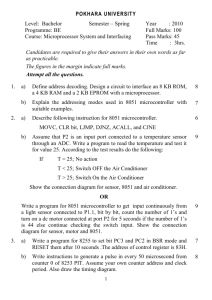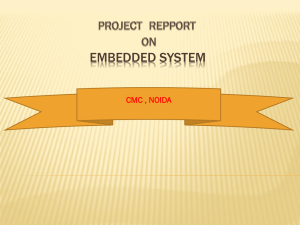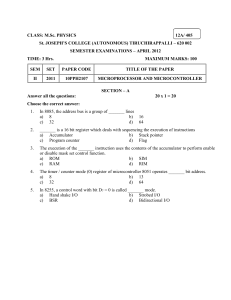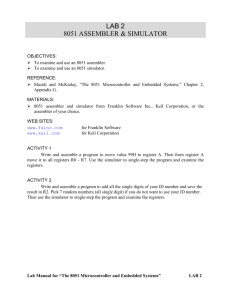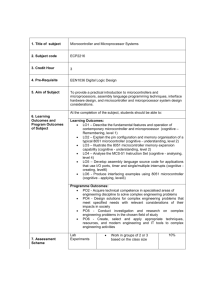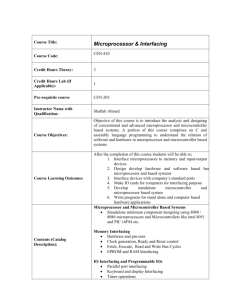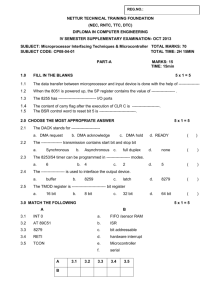File
advertisement
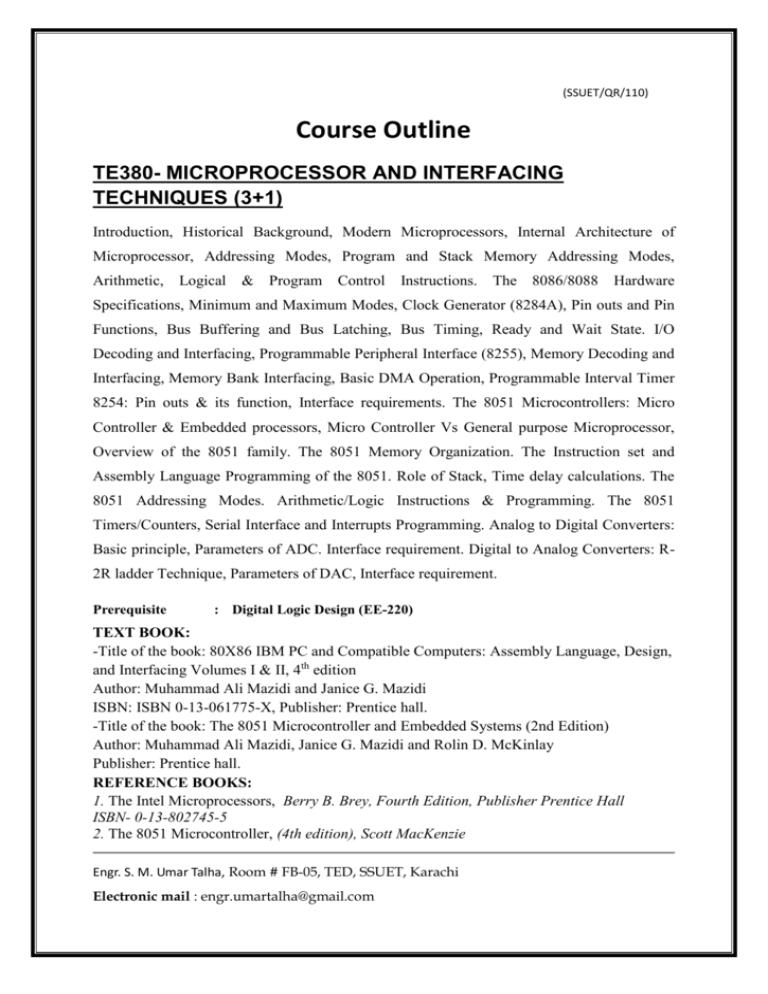
(SSUET/QR/110) Course Outline TE380- MICROPROCESSOR AND INTERFACING TECHNIQUES (3+1) Introduction, Historical Background, Modern Microprocessors, Internal Architecture of Microprocessor, Addressing Modes, Program and Stack Memory Addressing Modes, Arithmetic, Logical & Program Control Instructions. The 8086/8088 Hardware Specifications, Minimum and Maximum Modes, Clock Generator (8284A), Pin outs and Pin Functions, Bus Buffering and Bus Latching, Bus Timing, Ready and Wait State. I/O Decoding and Interfacing, Programmable Peripheral Interface (8255), Memory Decoding and Interfacing, Memory Bank Interfacing, Basic DMA Operation, Programmable Interval Timer 8254: Pin outs & its function, Interface requirements. The 8051 Microcontrollers: Micro Controller & Embedded processors, Micro Controller Vs General purpose Microprocessor, Overview of the 8051 family. The 8051 Memory Organization. The Instruction set and Assembly Language Programming of the 8051. Role of Stack, Time delay calculations. The 8051 Addressing Modes. Arithmetic/Logic Instructions & Programming. The 8051 Timers/Counters, Serial Interface and Interrupts Programming. Analog to Digital Converters: Basic principle, Parameters of ADC. Interface requirement. Digital to Analog Converters: R2R ladder Technique, Parameters of DAC, Interface requirement. Prerequisite : Digital Logic Design (EE-220) TEXT BOOK: -Title of the book: 80X86 IBM PC and Compatible Computers: Assembly Language, Design, and Interfacing Volumes I & II, 4th edition Author: Muhammad Ali Mazidi and Janice G. Mazidi ISBN: ISBN 0-13-061775-X, Publisher: Prentice hall. -Title of the book: The 8051 Microcontroller and Embedded Systems (2nd Edition) Author: Muhammad Ali Mazidi, Janice G. Mazidi and Rolin D. McKinlay Publisher: Prentice hall. REFERENCE BOOKS: 1. The Intel Microprocessors, Berry B. Brey, Fourth Edition, Publisher Prentice Hall ISBN- 0-13-802745-5 2. The 8051 Microcontroller, (4th edition), Scott MacKenzie Engr. S. M. Umar Talha, Room # FB-05, TED, SSUET, Karachi Electronic mail : engr.umartalha@gmail.com (SSUET/QR/110) Sir Syed University of Engineering and Technology Karachi Telecommunication Engineering Department Subject: MICROPROCESSOR AND INTERFACING TECHNIQUES (TE-380) Course outline Course Title: MICROPROCESSOR AND INTERFACING TECHNIQUES Course Code: TE-380 Credit Hours: 3+1 Semester: 6th Course Instructor: Engr. S. M. Umar Talha Aims & Objectives: To introduce the basic architecture of microprocessor and microcontroller. To learn assembly language and the technique as how to implement it with microprocessor and microcontroller systems. To develop an in-depth understanding of: - The operation of microprocessors and microcontrollers - Microprocessor interfacing techniques To be able to design and implement microcontroller and microprocessor-based systems in both hardware and software Learning Outcomes: Having successfully completed the course, you will be able to demonstrate knowledge and understanding of: Identification of the internal registers & architecture of processor memory organization The knowledge of system architecture for assembly language programming. Design of interface circuits for microprocessor & microcontrollers. Developing assembly language codes to interface controlling device. Course website and email address: Website: www.umartalha.weebly.com Course Email: micro.te380@gmail.com (SSUET/QR/111) Sir Syed University of Engineering & Technology, Karachi Department of Telecommunication Engineering Subject: MICROPROCESSOR AND INTERFACING TECHNIQUES Lecture Plan Week # Lecture# Lecture 1 Week 1 Lecture 2 Lecture 3 Lecture 4 Lecture 5 Week 2 Lecture 6 Lecture 7 Week 3 Lecture 8 Lecture 9 Topics Book Chapter No Introduction -Historical Background -Modern Microprocessors -Microprocessor in Personal Computers Internal Architecture of Microprocessor 01 Real Mode Addressing Mode Protected Mode Addressing Mode Memory Paging Addressing Modes: Register, Immediate, Direct Addressing Register Indirect, Base Plus Index Addressing Register Relative Addressing Base Relative Plus Index, Scaled Index Addressing Direct Program Memory Addressing Relative Program Memory Addressing Indirect Program Memory Addressing Push/Pop and Call Instruction Arithmetic and Logical Instructions: -Addition, Subtraction, Comparison Multiplication and Division Basic Logical Instructions Shift and Rotate Instructions Assignment /Quizes Lab % of course coverage Lab #01 2% 01 2% 01 2% 02 2% 02 Assignment #1 2% Quiz #1 02 2% 03 Lab # 02 2% 03 Assignment #2 2% 03 Quiz #2 2% 04 Lecture 11 Program Control Instructions: -Conditional & Unconditional Jumps Procedures 04 2% Lecture 12 Introduction to Interrupts 04 2% Lecture 13 8086/8088 Hardware Specifications: 06 Lecture 10 Week 4 Week 5 Lecture 14 Lecture 15 Lecture 16 Pin outs and Pin Functions Pin Functions and Connections (contd.) Lab # 4 Assignment #3 2% Lab # 5 2% 06 Minimum and Maximum Modes 06 Clock Generator (8284A): 07 2% 2% 2% Week 6 Lecture 17 Internal Block Diagram Pin outs and Pin Functions Bus Buffering and Bus Latching 07 2% Lecture 18 Bus Timing Ready and Wait State 07 Lecture 19 Memory Interface: 08 Lecture 20 Memory Devices Memory Pin Connections ROM Memory DRAM Memory Address Decoding: Lecture 21 Simple NAND Gate Decoder 3-8 Line Decoder 74LS138 2-4 Line Decoder 74LS139 PLD Programmable Decoders Basic I/O Interface: Week 7 Isolated I/O Memory Mapped I/O Personal Computer I/O Map I/O Ports Address Decoding 2% 2% 08 2% 08 Quiz # 3 2% Lecture 22 Week 8 Lecture 23 Lecture 24 Lecture 25 Lecture 26 Week 9 Lecture 27 Programmable ICs: Programmable Peripheral Interface (8255) Programmable Timer Counter (8254) Universal Synchronous Asynchronous Receiver Transmitter (8251) Introduction to Microcontrollers: Microcontroller & Embedded processors Microcontroller Vs General Purpose Microprocessor Overview of the 8051 family The 8051 Pin Outs: I/O Port structure The 8051 Memory organization The 8051 Memory organization (cont.) 10 2% 10 2% 10 2% 01 Lab # 07 2% 01,02 6% 02,03 General Purpose RAM Bit-addressable RAM Register Banks Special Function Registers: (PSW, B register, Stack Pointer, Data Pointer, Port Registers, Timer Registers, Serial Registers, Interrupt Registers, Power Control Register) Lecture 28 Week 10 Lecture 29 Lecture 30 Addressing modes: Register Addressing Direct Addressing Indirect Addressing Immediate Addressing Relative Addressing Absolute Addressing Long Addressing Indexed Addressing 2% 06 05 05 Assignment #4 Lab # 07 cont. 2% 2% 2% Lecture 31 Week 11 Lecture 32 Lecture 33 Lecture 34 Week 12 Lecture 35 Lecture 36 Lecture 37 Week 13 Lecture 38 Lecture 39 Lecture 40 Week 14 Lecture 41 Lecture 42 The 8051 Microcontroller Instruction set: Arithmetic Instructions Logical Instructions Data transfer Instructions Boolean Instructions Assembly Language Programming of the 8051 Role of Stack, Time delay calculations The Timers/Counters Operation Introduction to the 8051 Timers/Counters TMOD and TCON Registers Timer Modes and Overflow Flag (Modes 0,1,2 & 3) Clocking Sources (Interval Timing / Event Counting) Programming the Timers/counters Baud Rate generation Serial Interface and Interrupts Programming Serial port Control Register Modes of operation (Modes 0,1,2 & 3) Initializing ands accessing Serial Port Registers Serial Port Baud Rates Serial Interface Interrupts Interrupt Introduction and organization Enabling & Disabling Interrupt priorities Polling Sequence Programming Interrupt service routines Serial Port Interrupt External Interrupts 06 Lab # 08 2% 06 06 2% Assignment #5 2% 09 Lab#13 2% 09 Assignment #6 2% 09 Quiz #4 10 2% Lab #15 2% 10 2% 10 2% 11 Lab # 11 Lab # 14 2% 11 2% 11 Assignment #5 2% Interrupt timings 13 Lecture 47 Analog to Digital Converters: Basic principle Parameters of ADC ADC Interface requirement ADC programming Digital to Analog Converters: R-2R ladder Technique Parameters of DAC Interface requirement Interfacing 8051 to External Memory Memory address decoding Lecture 48 8051 data memory space Lecture 43 Week 15 Lecture 44 Lecture 45 Lecture 46 Week 16 2% 13 13 2% Quiz 2% 14 2% 14 2% 14 2% Annexure A Lab# Title of Experiments a) Introducing the BGC-8088 Microprocessor training system. 1 b) Introducing the Syntax and use of the Assembler, Numerical and Program Execution commands of BGC trainer 2 To understand the basic assembly language instructions and performing basic arithmetic operations. a) Introducing DEBUG programming (at command prompt using PC). 3 b)To learn how to create and assemble an executable Assembly Language Programming using Assembler and Linker programs To learn how to implement loop in assembly language. 4 5 To learn how a software program affects the hardware signals and their connections. a) Using MASM/TASM learn how to use different BIOS and DOS Interrupt Services. b) To demonstrate string handling in assembly. a) Introduction to Emulator (Emu8086), Stepper Motor and Traffic Light Modules 6 b) To perform some computation by using Assembly Language Programming. To generate Fibonacci series To generate BCD arithmetic a) To examine and use an 8051 assembler, simulator. 7 8 b) Introduction to MTS-51 Microcontroller Trainer and to demonstrate the interface of LED pack with the microcontroller on the MTS-51 Trainer. a) To demonstrate the interfacing of seven segment with the microcontroller on the MTS-51 Trainer. b) To demonstrate the on-board Speaker control with the microcontroller on the MTS-51 Trainer. 9 To demonstrate the interfacing and control of 8x8 dot matrix LED (D3), and use it to display static and dynamic alphabets and decimal numbers. 10 To learn Step Motor interfacing and to control the 4-phase step motor M1 on MTS-51 Trainer 11 To Interface matrix keyboard control with microcontroller. Using the matrix keyboard control to control available output devices on MTS-51 Trainer 12 This experiment demonstrates the application of LCD module (LCM). 13 To learn on-chip Timer/ counter control and their operation in Modes 0 and 1. Demonstrate the operation of basic pulse counter. 14 15 To demonstrate the control application of photo interrupter. To demonstrate the Serial Communication using on-chip serial port Mode 1. To demonstrate the Input and output port expansion using serial port Mode 1.
